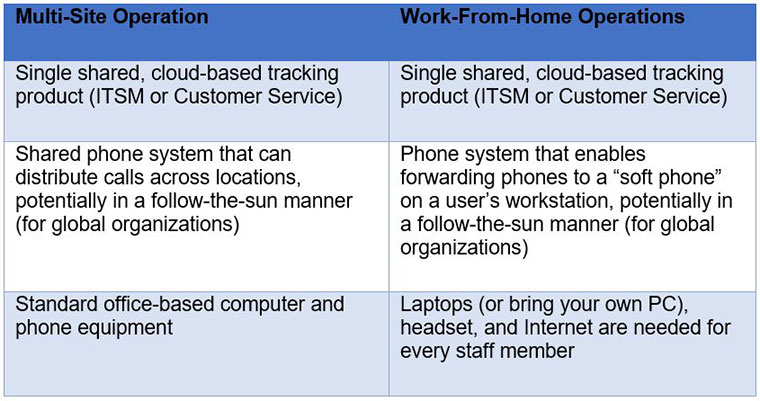Date Published July 8, 2020 - Last Updated December 10, 2020
Business continuity via a hot site is expensive, reactive, and disruptive to staff who need to travel to that site, leaving their families behind. Today’s business environment is also far more automated and technology dependent than years ago, requiring more staff to re-locate to a hot site if there’s a threat to corporate locations and data centers. This article looks at applying what we learned about business continuity from COVID-19 but applies it to a long-term continuity strategy for service and support organizations. It’s the first in a series that will look at the call center, the technology and application teams, and the role of the CMDB in empowering business continuity.
The Hot Site Isn’t the Only Answer
Traditional continuity strategies, in particular the concept of an off-site location to which a business will relocate critical staff, are not as agile as business has moved to an increasingly high-tech, high-touch operating model. Hot sites can also be quite expensive. While disaster recovery insurance might pay for these costs when invoked, the cost of additional down time while the business moves to the hot site and sets up for work makes them far more expensive than the option COVID-19 provided: moving the workforce to work from home.
Keeping the service desk and customer service call centers operational in the face of a disaster is easily achieved without the use of hot sites when the organization is equipped to operate virtually. Bringing the work force home is not the only answer as some disasters can take out an entire area. Consider using both of these arrangements:
- Creation of a virtual call center across corporate/organizational locations
- Shifting workers to home-based operation
Taking a call center virtual through work-from-home and/or by splitting staff across several locations is a more immediate, lower-cost option than using hot sites for business continuity. Regardless of whether it’s a service desk or customer support operation, call centers are extremely easy to virtualize, enabling personnel to work as easily from home as they can in the office or enabling operations to shift to workers to another location. As this is an area where productivity is easy to measure, a team can be managed across a variety of locations.
Consideration and Planning
Each of the solutions I identified requires slightly different preparation, but there are some technology considerations to address before beginning, outlined in the table below:

Organizations that have a modern ITSM and/or CSM platform are likely already operating via the cloud, and most modern or IP-based call distribution products also have the soft phone capability mentioned. This can significantly lower the barriers to entering this type of arrangement.
Many organizations have worked hard to consolidate service desks or customer service operations into a single location. But it’s not the location that makes it effective to centralize; it’s the tools and management of the call center as a single, consolidated operation. The staff member’s location is far less important. Thus, locating staff in several office locations gives the organization the ability to land calls directly to the analysts and technicians, wherever they are. During a service interruption or localized disaster, the calls automatically re-route to agents in other locations. While this may seem simple, it is. That’s the beauty of going virtual rather than managing for disaster. This is call center 2020 and beyond: a virtual call center that operates from home during a pandemic and from home/other locations during a local disaster.
Adding Business Value
The business value of this solution comes from its simplicity, immediacy, and lack of impact. If calls simply re-route during an emergency, the worst business impact is increased wait times while agents get online from home rather than the office. The other locations pick up the volume temporarily. But within hours, agents can be online from home, bringing operations back to normal. In the case of a weather disaster, staffing may not be as high, but the call center is still operational. In the case of a pandemic, all agents leave work at the end of one shift and begin home-based operations for the next.
Within hours, agents can be online from home, bringing operations back to normal.

In many cases, little investment is needed. But where new systems are needed, these are one-time investments that can be paid for with the budget for maintaining off-site locations for use in a disaster, ultimately lowering costs in subsequent years.
Phyllis Drucker is an ITIL® certified consultant and information leader at Linium, a Ness Digital Engineering Company. Phyllis has more than 20 years of experience in the disciplines and frameworks of IT service management, as both a practitioner and consultant. She has served HDI since 1997 and itSMF USA since 2004 in a variety of capacities including speaker, writer, local group leader, board member, and operations director. Since 1997, Phyllis has helped to advance the profession of ITSM leaders and practitioners worldwide by providing her experience and insight on a wide variety of ITSM topics through presentations, whitepapers, and articles and now her new book on the service request catalog, Online Service Management: Creating a Successful Service Request Catalogue (International Best Practice). Follow Phyllis on Twitter @msitsm.